Sunday, 18th December is the date that many have been waiting for. France will face Argentina at the Lusail Iconic Stadium in the final of the FIFA World Cup 2022. France will look to win back-to-back trophies, becoming only the third team to do so, while Argentina will attempt to win their third World Cup, the first in 36 years.
Set pieces have been a fairly quiet theme during this World Cup, but in a game as tight as this one, one corner could be the difference between winning and losing the World Cup. From the get-go, Argentina look to be disadvantaged in this part of the game, due to their smaller squad in terms of height. Only Cristian Romero and Nicolas Otamendi are over 180cm tall for Argentina based on their predicted starting lineups, and should Lisandro Martinez start over one of them, Argentina will be left with only one outfield player over 180cm.
On the other hand, France’s squad is filled with a physical presence, with six of their predicted starters being over 180cm tall. The mismatch in height has the odds swayed in France’s favour, and this preview will look in depth to see if France are clear favourites from set pieces.
In this tactical analysis, we will delve into the tactics that both France and Argentina have used for corners and free kicks. There will be an analysis of every set piece that each team has taken in the World Cup to determine the effectiveness of both sides. Furthermore, we will look at how the two sides match up with their offensive and defensive strategies, and where chances may appear during those set plays.
The set-piece analysis will show discuss both team strengths and weaknesses, and come up with ways in which both teams could shock one another to create chances from set-pieces.
France’s threat
France’s set-piece taker for both corners and free kicks has been Atletico Madrid‘s Antoine Griezmann. His deeper role in this tournament has highlighted his passing skillset, which is as good as any other part of his game. He has taken nearly every set play that was available to him, and his strong pinpoint deliveries have led to a number of goals and great goalscoring opportunities.
Below we can see a map of his shot assists during the World Cup. This map also has a couple of assists from open play, but to have nearly 3 xA from five starts shows just how creative Griezmann is, and we will likely see more of his teasing deliveries in the final.
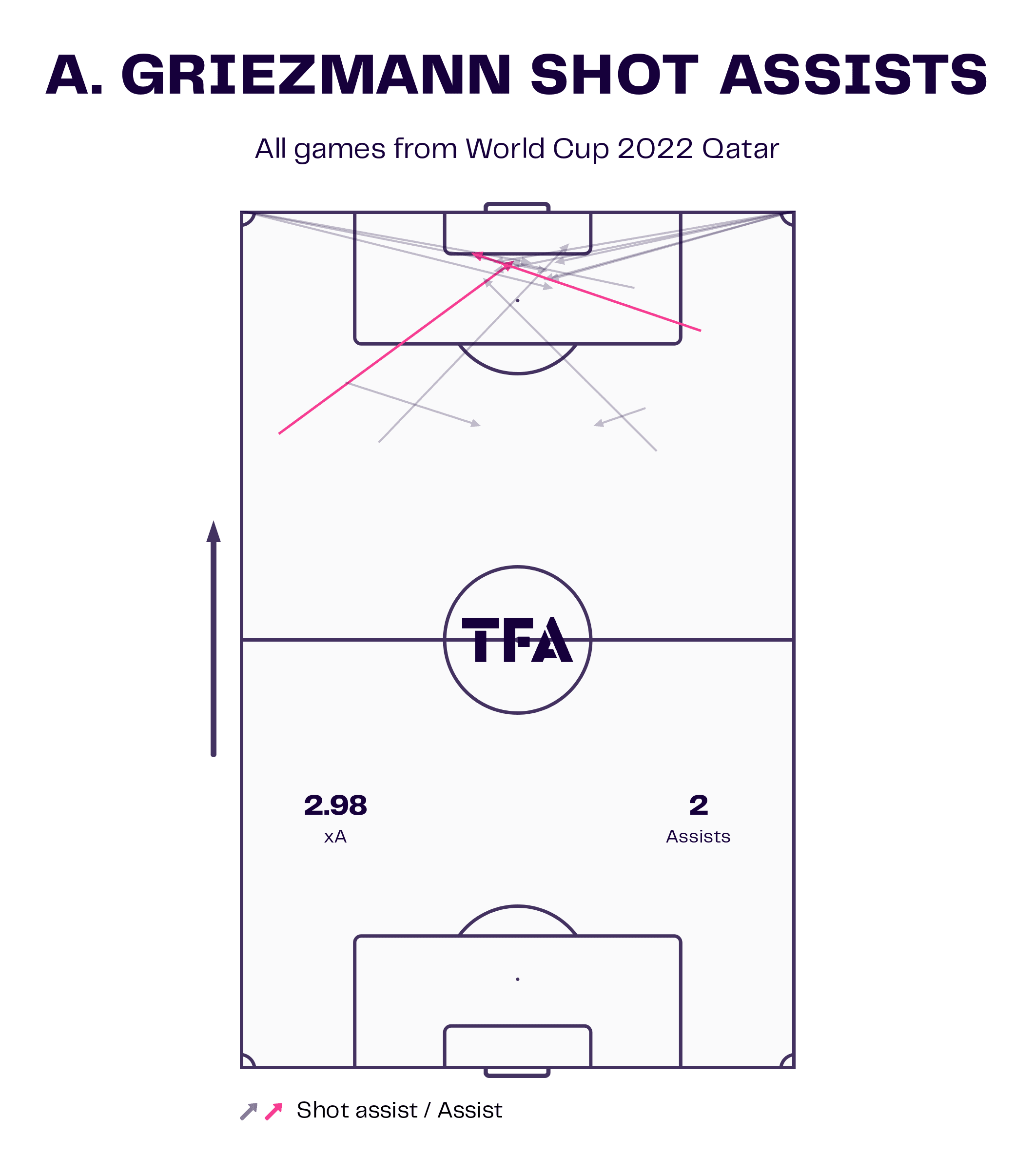
Antoine Griezmann takes corners from both sides of the pitch, and France’s attacking movements depend on the side the corner is taken from. On both sides, rather than precoordinated movements, France rely on individual aerial quality, which they have in abundance, to make the first contact. All the players start between the penalty spot and the edge of the box and make their movements once the kick is taken.
From the left-hand side, where the ball is out swinging, France’s players stay deep around the penalty spot. As the ball is delivered, it naturally starts closer to the keeper before curling away. As a result, it is difficult to place outswinging corners in and around the six-yard box, where it is easier for the goalkeeper to claim the deliveries. The delivery is therefore aimed towards the penalty spot, where it’s impossible for the goalkeeper to claim it, and France are reliant on the individual quality of their players to generate the power and accuracy of a floated ball. This is not a problem for France, as the usual five players attacking corners; Giroud, Tchouameni, Rabiot, Varane and Konate/Upamecano, are all capable of beating most opponents aerially and have the heading ability to cause danger from 12 yards out.
From the right side, Griezmann’s inswing corners can be aimed closer to goal, where players only need to change the ball’s path, rather than its pace as well. These corners are predominantly aimed towards the front of the six-yard box, where a flick on towards goal can be enough to put it in the back of the net. These types of corners can be more difficult to precisely deliver, but Griezmann has proven time and again that he is more than capable of doing so.
As seen in the image below, four French players begin close to each other, before making different runs into the six-yard box. Having the French players begin close to each other prevents Denmark’s man markers from getting close enough to their player so some of the French players can have unopposed runs at the six-yard box where their running momentum will likely help them to out-jump the zonal markers. Olivier Giroud starts around the 6-yard box, so at least 1 person occupies the area, preventing the Danish players from starting further from goal, and being more likely to clear the ball. Mbappe’s role at the back post will be explained later on.
From this corner below, Aurelien Tchouameni’s run from deep allows him to get ahead of his marker, and have a headed effort from six yards out although it is placed off target.
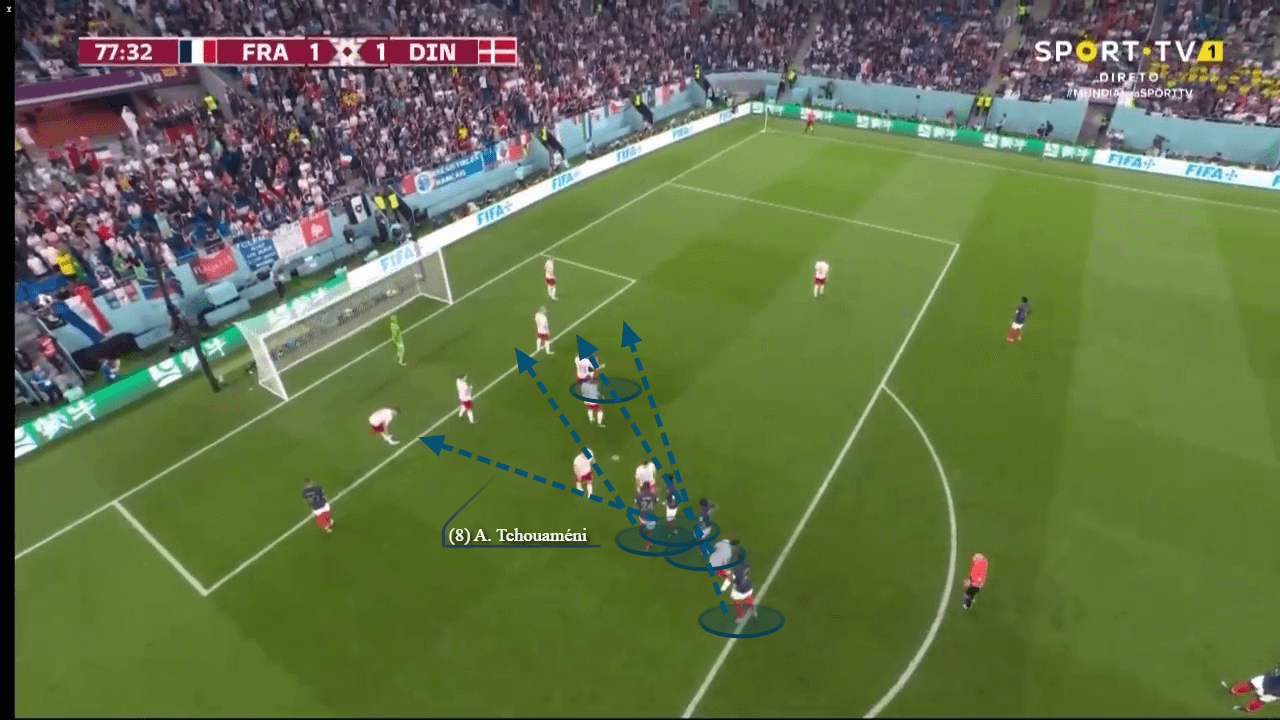
From the evidence above, it is quite clear that France rely on the individual quality of their players to make the first contact with the ball from corners. In the image below, we can see how Argentina will set up when defending corners. They have three zonal markers on the front of the six-yard box, and the rest are utilised as man markers. Man marking will perhaps be Argentina’s only hope to prevent the French players from having success, as France’s players would likely outjump any zonal markers from Argentina.
The man markers will hope to disrupt the attacking team, to prevent them from getting close to the path of the ball, rather than beating them in aerial duels. Argentina’s players are of course still aggressive in the aerial duels and will have success if the timing is right, but there will be no margin for error.
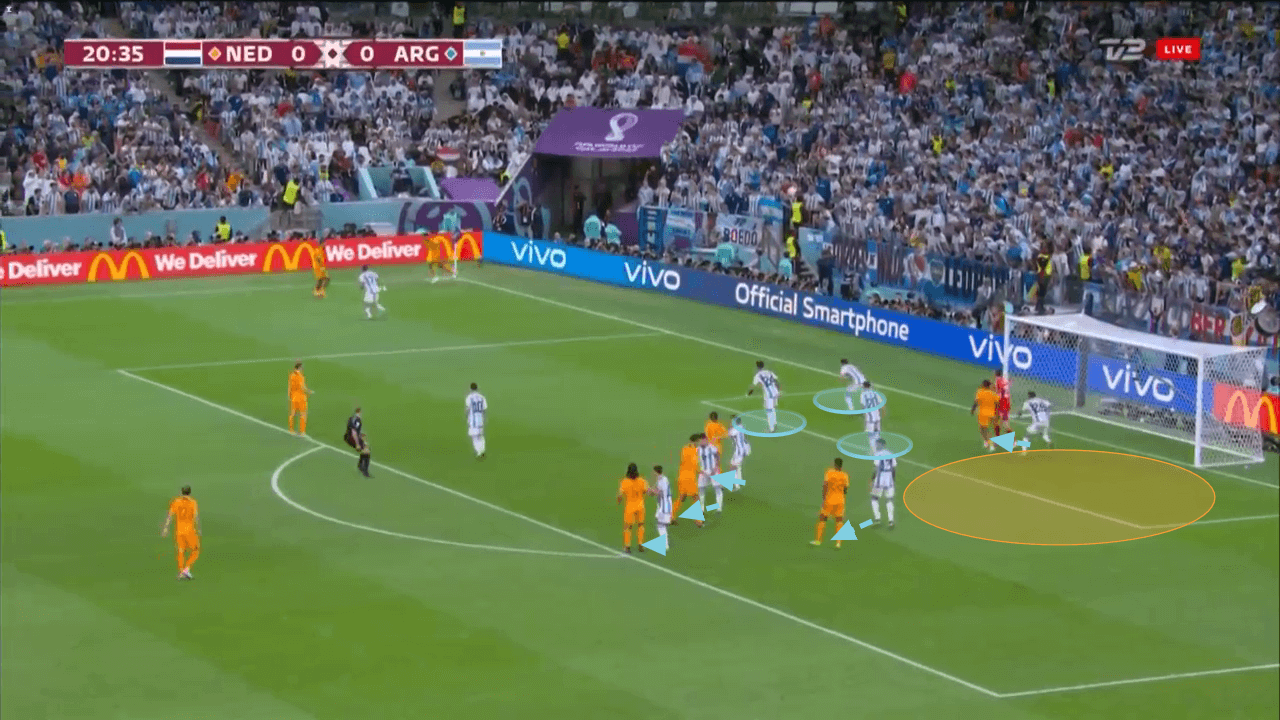
Problems could arise for Argentina should France’s attacking players clump together as the corner is taken. The man markers will be unable to get tight to their man, so it will be hard to disrupt the French runners. They will likely have many opportunities to compete for aerial duels where the odds will favour them due to their physical advantages.
Furthermore, Argentina appear to neglect the back of the six-yard box. The area is left completely open, and France could definitely take advantage of this opportunity. Man markers can be lost through clever movements, runs from deep or screens. If a French player can lose their marker by using a body feint, or with the help of a teammate screening someone, they will create separation. That one or two yards of separation will be all that a French player needs to lose their marker, and attack the back post completely unopposed, with a free header from six yards or possibly less.
France are able to be threatening from many different situations, with the ability to create from second balls giving them another dimension. During corners, Theo Hernandez and Ousmane Dembele set up on either side of the box, while either Kounde or Upamecano will sit slightly deeper and centrally. Mbappe, who usually lurks around the back post, immediately back-pedals to the far side of the box while Griezmann does the same on the near side. As a result, France have a basket-case of five players, who immediately collect any ball that is cleared out of the box. This allows them to get the ball back into the box straightaway, and provide the French players with another opportunity to get their heads on the ball.
Having elite crossers of the ball in Hernandez and Dembele makes France extremely threatening during the second phase. Through this element, France scored their equaliser against Australia, a decisive winner against England and also had a goal disallowed against Poland. The half space crosses from deep, while the defensive line is stepping up and French players move in the opposite direction, have proven to be as dangerous, if not more so than the original ball going into the box.
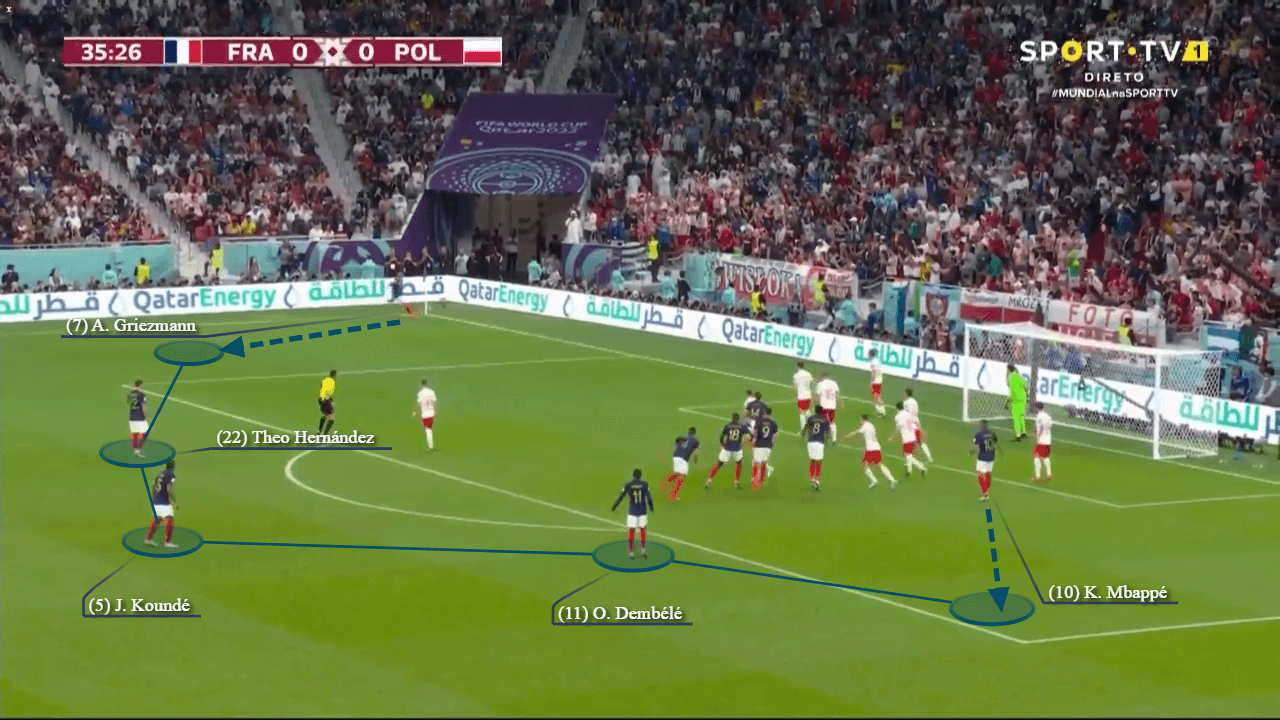
France will be able to cause danger to Argentina through free kicks like they have done so on a number of occasions already. From crossed free kicks, France keep the players on the edge of the box like they do for corners, whilst increasing the number of players attacking the cross.
Raphael Varane’s role in these free kicks has proven to be extremely important, and slightly unique. Varane begins in an offside position, out of sight of any defenders. As the free kick is about to be taken, he times his movement to be in an onside position. This late movement provides two different benefits for the Manchester United centre-back. Firstly, no defender has time to be looking behind them as the cross is about to be delivered, which leaves Varane difficult to mark. When Varane moves onside, defenders have one second to come to a decision, which can often lead to mistakes.
Furthermore, Varane uses his positioning to latch on to someone who already is marking someone else. In the image below, we can see Varane move to a Moroccan player who is already marking another Frenchman. In doing so, France have a 2v1, whilst other Moroccan players are only protecting space.
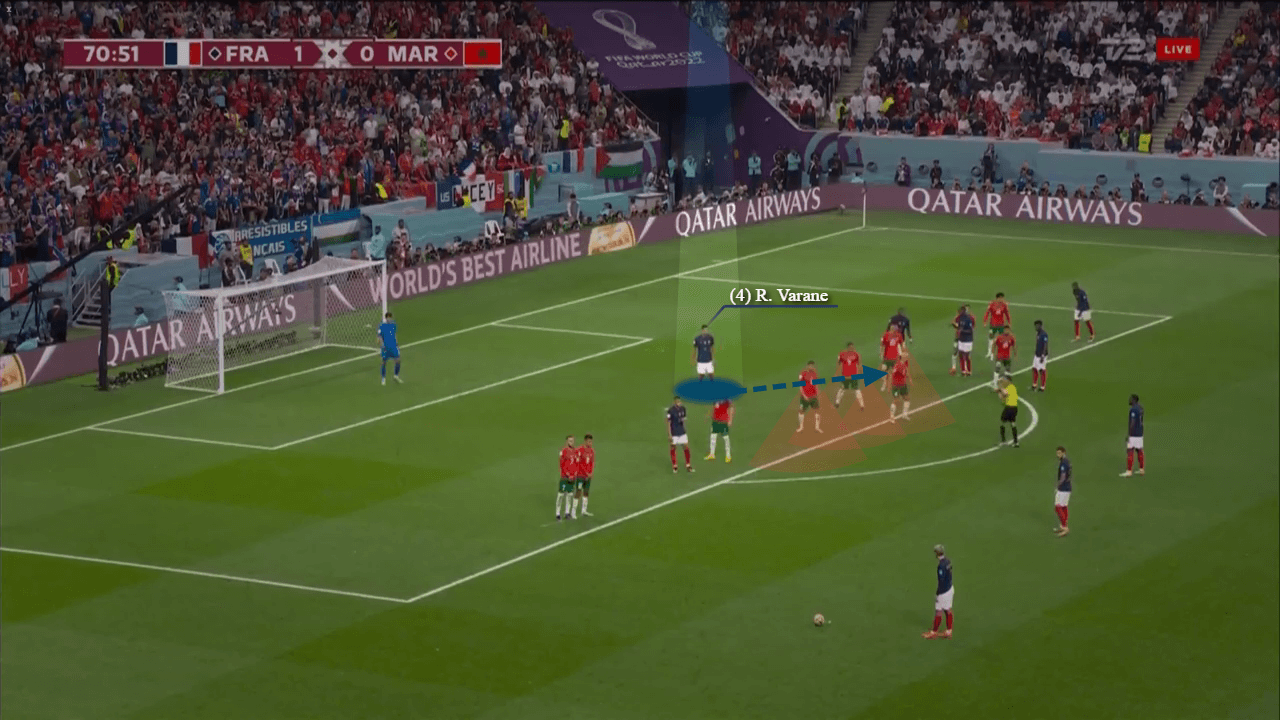
As we see from the next frame, this gives France a simple headed opportunity. The early jump from Varane causes the defender behind to lose track of the ball and also prevents the defender from jumping as Varane is pretty much on top of them. Konate is then left with an unopposed leap for the ball, which he easily gets to but fails to make a connection with the ball. Varane’s selflessness in these situations can lead to easy opportunities for his teammates.
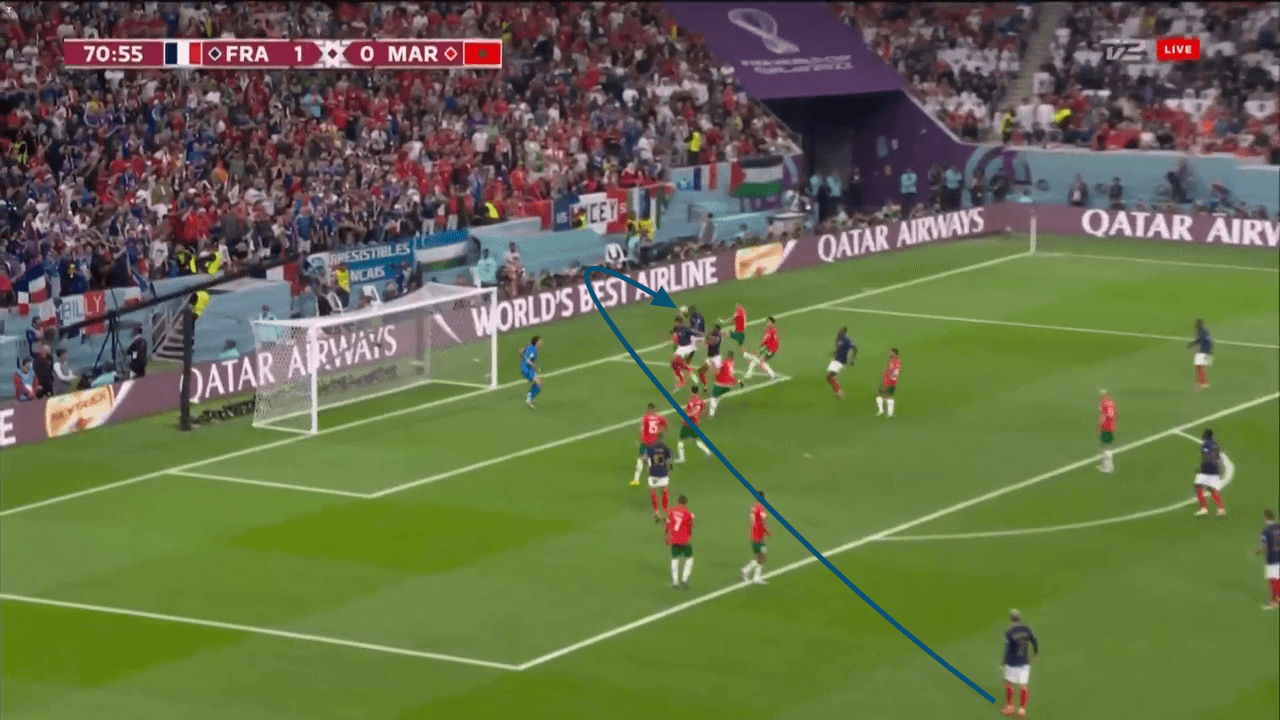
Argentina’s set piece potential
Although Argentina aren’t the tallest team, Lionel Messi’s impeccable crossing accuracy can help them to create dangerous opportunities from corners. From both sides, Argentina aim to overload the front post area, from where they need to redirect the ball rather than producing power with their headers. There are usually four players who make similar runs to the front of the six-yard box, whilst one player attacks the back post in case the ball ends up there, through a rebound or missed clearance.
Teams usually mark the front of the six-yard box, but the laser-guided crosses from Messi can often be so accurate, that they evade all opponents and end up on an Argentine head.
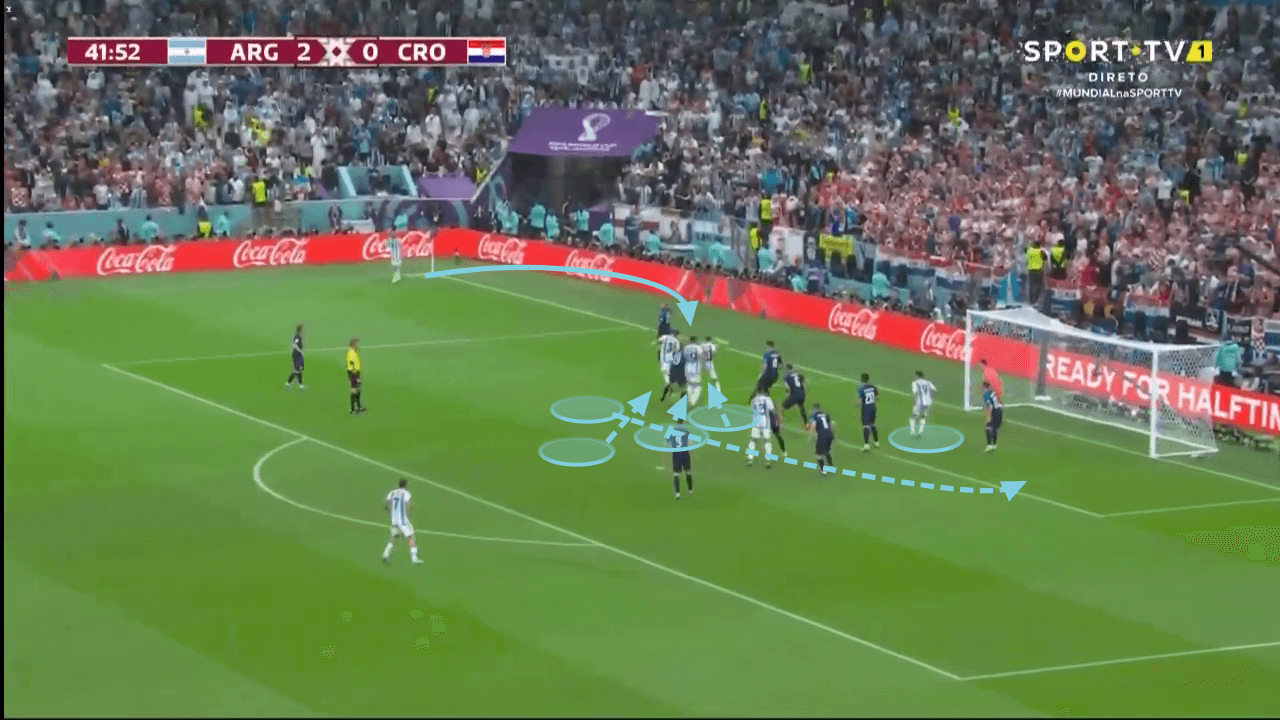
France have defended similarly to Argentina, where they mark the front of the six-yard box zonally, leaving the rest to mark man to man and neglect the back post. Argentina will hope to expose this defensive set-up by carrying on with their near-post crosses, where they should be able to get in front of their defenders to get to the ball first. France would be smart to throw in an additional body or two at the near post to give Messi next to no space to aim for.
While the back post is open, France will be less worried about this, as Argentina lack the number of powerful headers of the ball. However, should Argentina use screens or body feints to attack the back post, that separation could be enough to produce a clear headed opportunity, which from six yards out, will have a good chance of going in. If Argentina can time a screen well enough, someone like Julian Alvarez could have enough time to peel to the back post to even have a volleyed effort on goal.
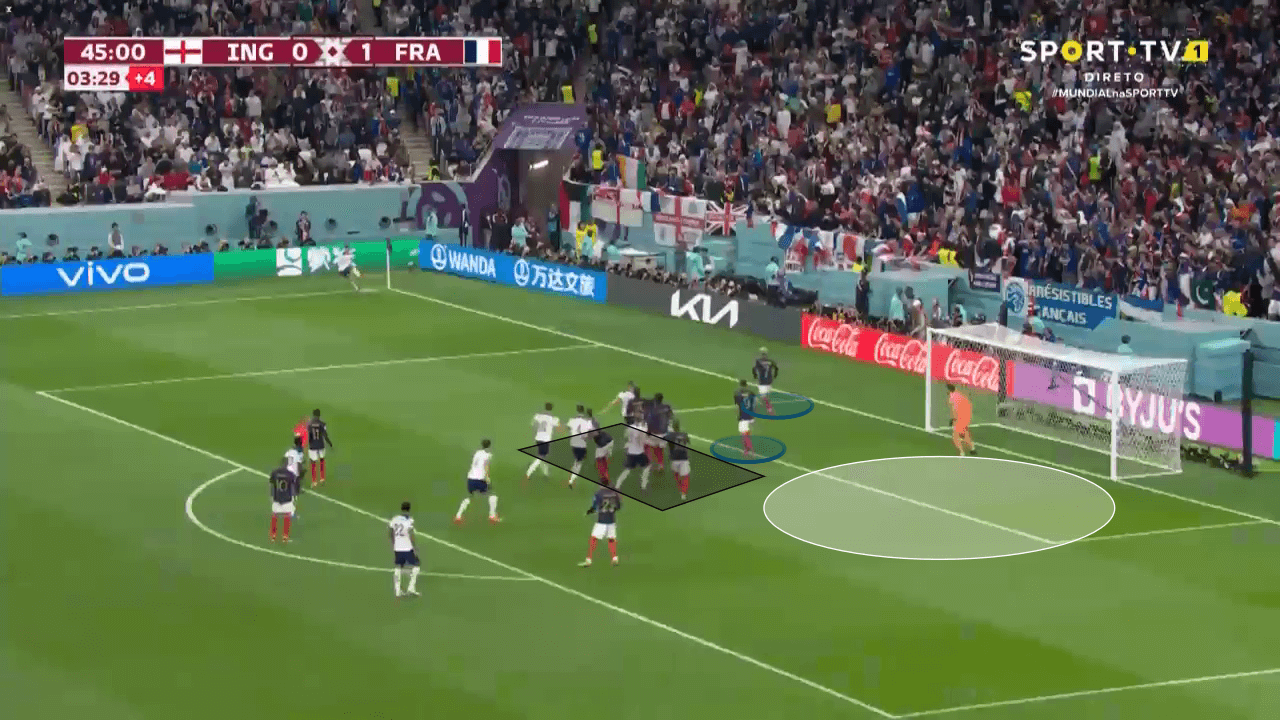
If Messi continues with his precise deliveries, Argentina could well score a chance similar to this Denmark goal. A near-post cross, which is flicked on towards goals. The back post is left open by France, which allows Barcelona‘x Andreas Christensen to head the ball into an open net from three yards out.
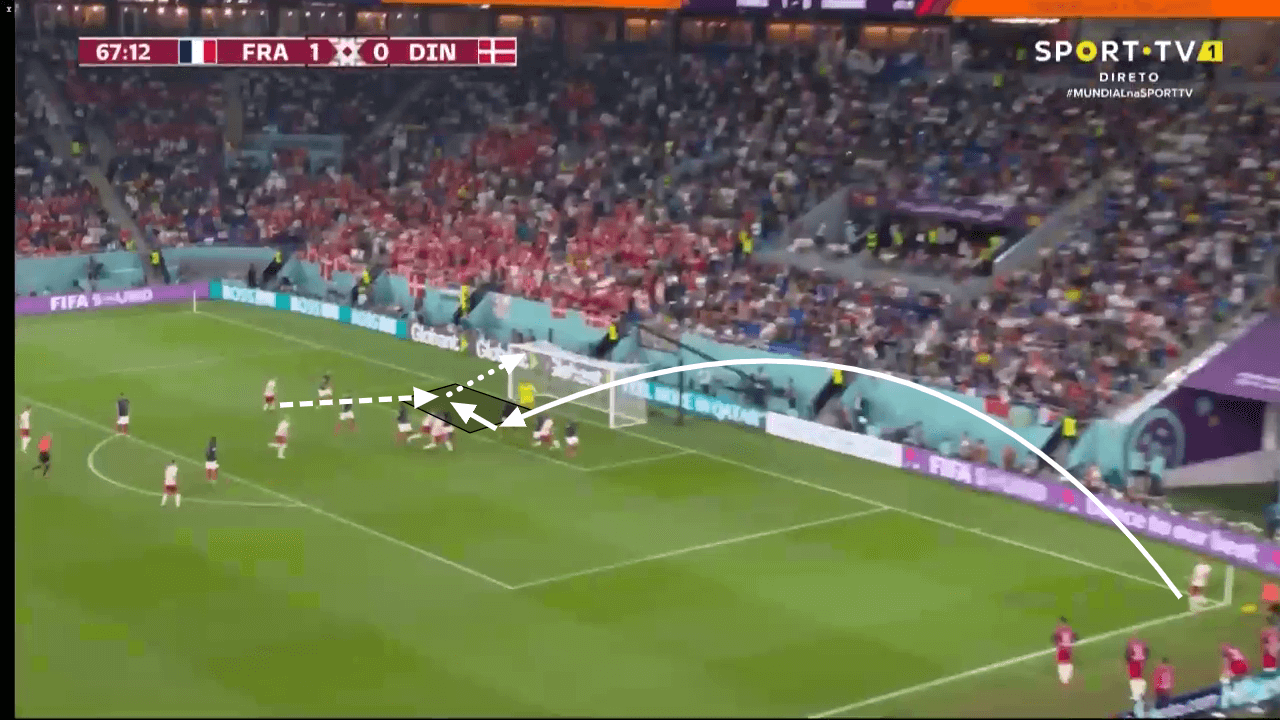
One way in which you can counter such corners is by overloading the front post defensively. This could be a smart approach from France, as it eliminates the possibility of any near post flick-on. Space would be created further from the goal, but France should trust their combined aerial quality, and lack of physicality from Argentina so that even a header from the penalty spot wouldn’t cause much trouble for Hugo Lloris.
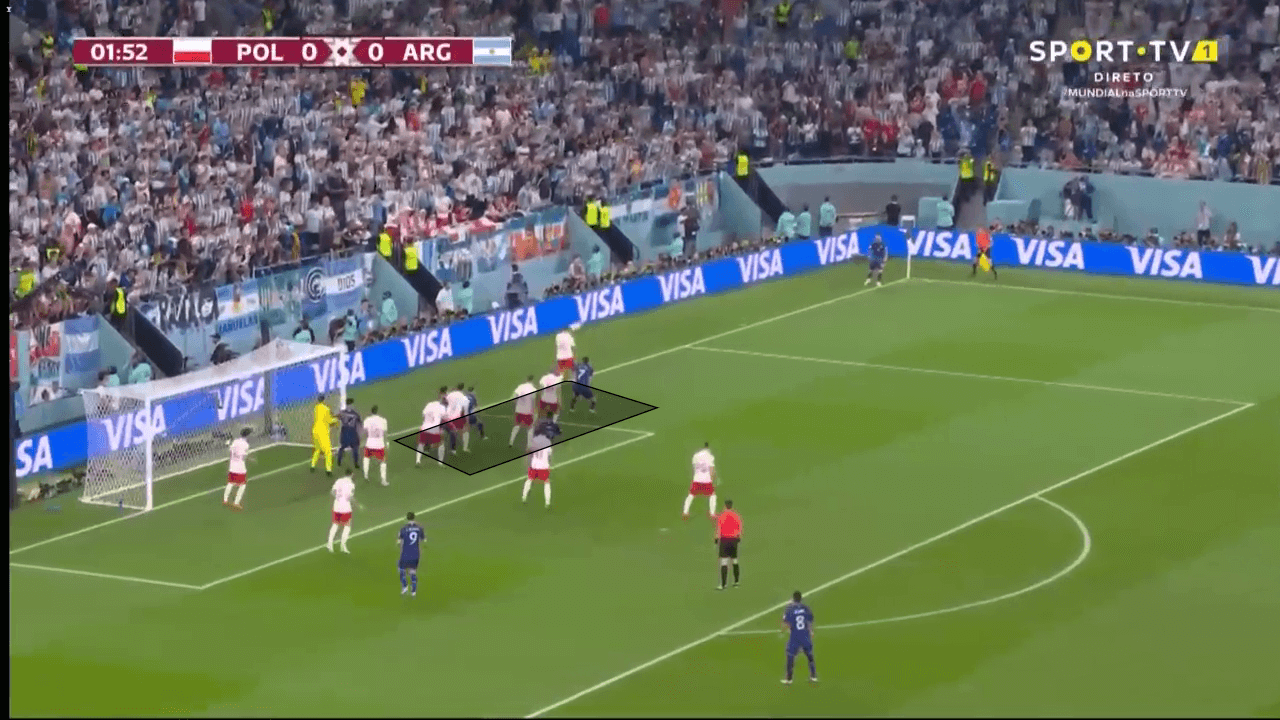
One final threat that Argentina do possess is their ability to play short and combine. They have a large number of highly technical players, who can all combine with each other to get close to goal. Furthermore, Enzo Fernandez has on multiple occasions taken a shot from distance after a short corner, which has led to both goals and dangerous opportunities for his team.
Conclusion
This tactical analysis has displayed the ways in which set pieces could play a role in the World Cup final this Sunday. France has the physical advantage from an aerial perspective, although Messi’s precision can help Argentina match France’s threat. Both teams have had a number of days to prepare for this final, so it is exciting to wait and see if any team comes up with anything out of the norm to gain that vital edge over the other.
France can create chances through well-timed movements, pure aerial dominance or second-phase deliveries, whilst Argentina will be more reliant on a precise delivery, which can be predictable. One rehearsed moment from a corner could decide the next World Cup winner, so both teams must pay the utmost attention to this area of the game.






Comments